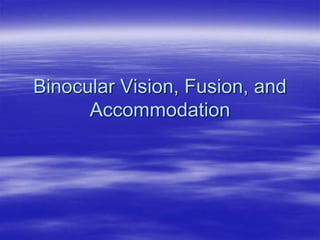
binocular-vision-fusion-and-accommodationluchansky-1937-1937.ppt
- 1. Binocular Vision, Fusion, and Accommodation
- 2. Fusion Development in the Infant Birth – fixation reflex poor with random eye movements 2-3 weeks – follows light monocularly 6 weeks to 6 months – follows light binocularly 4 weeks to 6 months – convergence developing By 6 months – accommodation developing – lags behind convergence
- 3. Fusion Sensory fusion – the cortical process of blending the images from each eye into a single binocular stereoscopic image Motor fusion – the mechanism that allows fine-tuning of eye position to maintain eye alignment – this is known as fusional vergence
- 5. Approximately 70% of the cells in the striate cortex are binocular cells Retinal areas from each eye that project to the same binocular cortical cells are called corresponding retinal points.
- 7. Worth’s Three Degrees of Fusion Simultaneous perception Flat fusion Stereopsis
- 9. Flat Fusion Worth Four Dot Test
- 10. Stereopsis Titmus Stereo Test
- 11. Binocular Single Vision Separate and slightly dissimilar images arising in each eye are fused together as a single image.
- 12. Advantages of Binocular Vision Single Vision Stereopsis Enlargement of visual field Compensation for blind spot and other differences in the field of vision
- 13. Normal Binocular Single Vision Requirements Clear visual axis Sensory fusion Motor fusion
- 14. Sensory Obstacles Dioptric obstacles – refractive errors, anisometropia Prolonged monocular activity – severe ptosis, media opacities Retinoneural – lesions of retina, optic nerve Proprioceptive
- 15. Motor Obstacles Congenital craniofacial malformations Conditions affecting extraocular muscles CNS lesions – involving upper motor neurons
- 16. The Perception of Depth Stereopsis Monocular clues to depth
- 17. Monocular Clues to Depth Relative size Interposition Linear perspective Aerial perspective Light and shade Motion parallax
- 23. Visual Direction Local sign – positional information transferred from the retina to the motor system – the fovea has a retinomotor value of zero Retinal correspondence = single vision Retinal disparity = diplopia
- 26. Cyclopean Eye
- 27. The Perception of Space Retinal corresponding points Horopter Retinal disparity Panum’s fusional area Physiological diplopia
- 28. The Horopter Vieth-Muller Circle Empirical Horopter
- 29. The Horopter
- 31. Normal binocular single vision – the images of the fixated object are bifoveal with no manifest deviation of the eyes Anomalous binocular single vision – the images of the fixated object are projected from the fovea of one eye and an extrafoveal position in the other eye – there is a small manifest deviation of the eyes
- 32. Misalignment of the two eyes can lead to diplopia and confusion Diplopia – occurs when one object is seen in two places Confusion – occurs when two dissimilar objects are seen in the same place
- 33. Suppression and Retinal Rivalry Suppression Normal – physiological diplopia – also known as suspension Anomalous – pathological diplopia and confusion – cortical inhibition of suppressed eye Retinal or binocular rivalry – rapid alternation of dissimilar images
- 34. Testing Retinal Correspondence Bagolini lenses Red filter test Worth four dot test Hering-Bielschowsky afterimage test Foveo-foveal test of Cuppers
- 37. Worth Four Dot Test
- 38. Testing Suppression Worth four dot test Polaroid vis-à-vis test Amsler grid 4 prism diopter base out test Red filter test Bagolini lenses
- 39. Polaroid Tests
- 40. Amsler Grid
- 41. Versions – conjunctive eye movements – the two eyes move in the same direction Pursuits Saccades
- 42. Vergences – disconjunctive eye movements – the eyes move in opposite directions Convergence Divergence Vertical vergence
- 43. Vergence Tonic Proximal Fusional Accommodative
- 44. Accommodation Tonic – in the absence of a visual stimulus, the accommodation adopts an intermediate position of 0.5-1.0 D Proximal – resulting from apparent nearness of an object Convergence – accommodation linked to convergence Reflex – involuntary response to blur to maintain a clear image Voluntary – not dependent on a stimulus